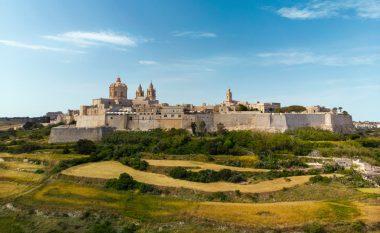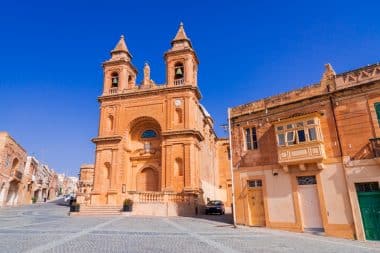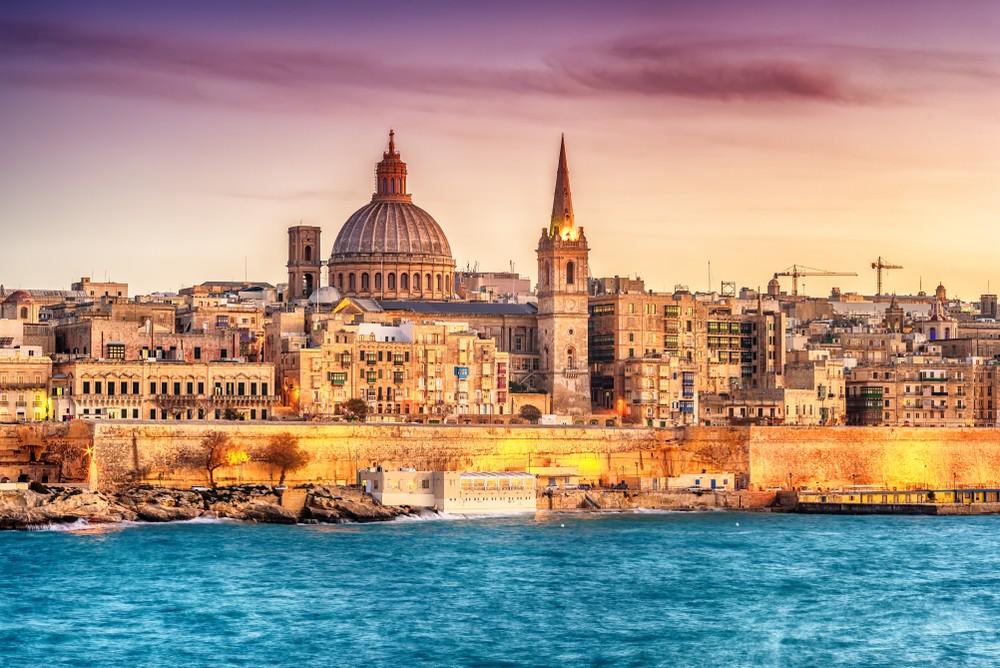Before planning a trip to Malta, you need to know where Malta is located. An amazing island nation in the heart of the Mediterranean. The attractiveness of this place is determined by hundreds of churches, ruins temples, medieval fortresses, ancient palaces, cathedrals and squares, phenomenal rocky coasts, countless nightclubs and restaurants.
Malta is an archipelago of the Maltese Islands. Due to its location between Europe and Africa, it is a kind of center of cultures. Architecture, language and traditional cuisine are influenced by Italian, British, French, Turkish and North African languages. This is the only European country where there are no permanent rivers and natural reservoirs.
Many come to the island to study at English schools. Studying in Malta is 20-30% cheaper than in other European countries. Language courses on the island are open to preschoolers, pupils, students and retirees, so all options are open to anyone who wants to improve their English.
Mild sunny climate, warm sea and warm air can cure many diseases and relieve stress. There are many well-equipped clinics on the islands, where hot tubs, therapeutic wraps, anti-aging masks, scrubs, lymphatic drainage, and other modern wellness treatments are used.
This country has another peculiarity. Malta is one of the few countries that issue a license for online gambling. This means that every MGA Casino regulated in the international legal field. In other words, Malta is a kind of hub for all businessmen working in the field of online gambling.
All this makes every corner of the island unique and inspires in very different ways. Malta’s cultural diversity, combined with the country’s richness and extraordinary landscapes, make this country very special. Well, let’s find out what you can see when you travel to Malta.
8. Valletta: the colorful capital of Malta
“Open-air museum” – that’s what they say about Valletta. This is not surprising, since there are up to 320 monuments in an area of less than 1 km². The capital of Malta is named after the head of the knights, Jean Parisot de la Valletta. The city, which is home to more than 6,000 people today, is located in the northeast of the island.
The city of Valletta is truly a special place, as the capital of Malta is on the UNESCO list. Of great importance here is the fact that Francesco Laparelli, a student of the famous Michelangelo, was the main designer of the city.
The central street of Valletta divides the city into two halves and ends near the medieval Fort of St. Elmo, which served as Malta’s main fortress. Today, the former fortress houses the collections of the National Military Museum and hosts parties of costumed knights.
Tourists often visit the Palace of the Grand Master, which used to be the residence of the Order of Malta and is now used by the country’s parliament and president. A tour of the building reveals several halls and a large arsenal of weapons.
A popular tourist attraction in Valletta is the medieval city gate of Putirial. The routes of all excursions in the Maltese capital include acquaintance with the three most famous temples – St. John’s Cathedral, St. Paul’s Cathedral and the sunken Church of St. Paul, where several Christian shrines are kept.
Worth seeing on the tour include the impressive Manoel Theatre – the third oldest in the world, the National Museum of Archaeology and numerous palaces and fortifications. Valletta is one of the most densely populated historic areas in the world, so there’s something for everyone.
7. Blue Grotto Malta: Caves in the Rocks
This is a group of unusual caves carved into rocky cliffs by sea waves. They are located in the southwestern part of the island of Malta and are only accessible from the sea. The Blue Grotto is known for its incredibly sky-blue waters. Stones made of different minerals that reflect sunlight give the water all kinds of bright and saturated hues, purple, pink, orange and other colors.
Multicolored mineral rocks on the bottom give the impression that the entire floor is covered with gemstones. In the caves, the water takes on an unusually rich blue-turquoise color. The deepest and darkest cave penetrates the rock at 45 meters. This natural wonder has been declared a national treasure.
In calm weather, you can reach the caves by tourist boat. The cave system consists of six halls, but the Blue Grotto Malta is the largest and most impressive. On a cloudy day, the cave is inconspicuous, all its beauty and splendor is revealed on a sunny day.
The ecosystem in the caves is also unusual: the salts contained in underwater currents create living conditions that can only be compared to the Galapagos Islands. The cave is home to exceptionally beautiful corals, and the adjacent waters are home to shells, lobsters, and giant sponges.
Mentions of the Blue Grotto on the island can be found in old documents, traditions and legends. Thanks to his extraordinary beauty, which touched Tiberius to the depths of his soul at the beginning of our era.
Unfortunately, the Blue Grotto Malta and other similar caves suffer enormous irreparable damage from pollution every year. Sometimes you have to close the cave to tourists. In 2010, the cave was closed due to the discharge of sewage into the sea, which led to pollution and poisoning of living organisms in the cave.
6. Popeye Village: just a fairy tale
An amusement park and one of the most popular tourist spots in Malta. Popeye resembles a fairytale village, which is not surprising since it was created in 1979 for the famous cartoon Popeye.
All tourists in the village are attracted by interesting, fabulous, colorful cottages and houses. From the side of the bay, they look particularly beautiful. As you walk through the streets of the village, you may meet cartoon characters.
Popeye Village is over thirty years old. There is a small hotel, a small zoo. The colorful houses also house a museum, the city of St. Nicholas, restaurants, and a gift shop. For the little ones there is a playground and a pool with slides. The fairytale village is open to tourists all year round.
5. Mdina: “the quiet city of Malta”

If you are looking for peace and relaxation, you should go to Mdina – a city located on the highest point of the island and surrounded by high walls. About 300 people currently live in the former capital of Malta.
The area of Mdina is pedestrian (with the exception of trucks or private cars of the residents), which is why the residents themselves call it a “quiet city”. Houses in Mdina do not have numbers and each has its own original name. Access for cars is limited here, hence the other name – “City of Silence”.
Mdina was once the original capital of Malta. The approximate age of this city is more than 3000 years. Much older than Valletta, the city is a maze of narrow, winding streets lined with sandstone-colored apartment buildings.
One of the most important sights of Mdina is St. Paul’s Cathedral. It was built on the spot where the first bishop of Malta met the apostle Paul, who had accidentally landed on the island due to a shipwreck. The Apostle Paul is the founder of Maltese Christianity and the patron saint of the island.
The city of Mdina is perfectly preserved, although he took part in many battles. It used to be part of the big city of Mdina. But when the Arabs ruled here, they decided to divide Medina into two parts. The rich stayed in Mdina, the poor got another part called Rabat.
The location of Mdina on a hill allows you to admire the panorama of the island. The city is surrounded by impregnable walls built by the Phoenicians as early as 900 BC. You can enter the city through the main gate, the Greek gate, and the new gate.
4. Rabat: In the footsteps of St. Paul
Rabat is actually a suburb of the popular Mdina. The former capital of Malta became too small for the rapidly growing population and people began to settle around it. Settlements expanded and today Rabat is one of the largest cities in Malta.
The city of Rabat has extremely rich architecture, museums covered with green vines. As you walk through the streets of Rabat, the characteristic Maltese houses stand out – low, square sandstone colors with colorful shutters.
But this city became famous for another reason. Legend has it that St. Paul lived here after his ship ran aground off the coast of Malta. In Rabat, you can visit a church built over a rock grotto where Paul is said to have lived. There are also two underground cemeteries in the city: the Catacombs of St. Paul and St. Agatha.
Rabat is one of the most environmentally friendly cities in Malta. There are many cozy little yards and squares with flowering shrubs and shady palm trees. Right next to the entrance to Mdina is a real park – Howards Gardens. The town has many typical Maltese medieval streets.
In general, the city looks spacious, quite green and well-kept, which is not typical for all Maltese cities. Rabat is home to many wealthy people, and in keeping with Maltese tradition, there are many expensive private homes, each with its own name.
Rabat is the exact opposite of Mdina. It is a lively, sunny city, full of life and quiet everyday pleasures, despite the gloomy underground catacombs. Many secrets of this time and beautiful sights have been preserved here, which we recommend visiting.
3. Dingli Cliffs: Fantastic Views of Malta
Malta island is generously gifted by Mother Nature. The Dingli cliffs – characteristic rock formations – bear witness to this. These are almost steep cliffs with a height of 253 meters, which were once formed by natural processes. Walking along the rocks, you can admire the fantastic scenery of the blue Mediterranean Sea.
The Dingli Cliffs are one of Malta’s most famous sights, but this is only a small part of the many kilometres of Maltese coastal cliffs that stretch along the south-west of the country. The Dingli Cliffs are incredibly beautiful formations that make you feel like a small grain of sand in the face of the forces of nature.
With a guide, you can hike to the cliffs of Dingli. You may not be able to study the rocks properly in the section. But from the top you have a wonderful view of the sea. To get to the rocks, you must first get to the town of Dingli, which is named after the rocks. For example, you can come by bus from Rabat and walk a few kilometers from the bus stop or rent a car.
Like any other attraction in Malta, the Dingli Rocks have their own secrets and mysteries that most tourists try to unravel. As you walk along the rocks, you may notice a series of small parallel grooves between the rocks. According to local residents and some historians, these are the remains of ancient carts. This is also evidenced by the remains of a quarry where boulders were mined for the construction of buildings on the island.
2. Marsaxlokk: Village of Colorful Boats

This small port town in the south of Malta is famous for its waterfront fish market. Fish, squid, crabs, mussels and prawns can be bought on site. The nearby restaurants serve Maltese cuisine and freshly prepared seafood. A characteristic feature of the Marsaxlokk landscape are traditional colorful fishing boats bobbing on the water. They have erect beaks and are decorated on the sides with the eye of the ancient Egyptian god Osiris, who is said to drive away evil spirits and protect them from being submerged. The boats moored in the bay are beautifully combined not only with the blue waters, but also with the sandstone buildings.
1. Mnajdra and Hagar Qim – the ancient temples of Malta
This is something for history buffs. On the south coast of Malta there are historical collections of massive megaliths. These are some of the oldest religious sites in the world. Both archaeological complexes – Mnajdra and Hagar-Kim – have been included in the UNESCO World Heritage List. Visitors can tour the ruins, where various chambers, corridors, and stone temples are well preserved.


